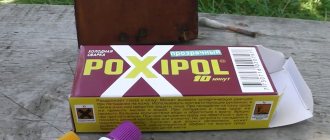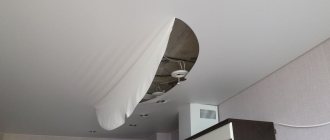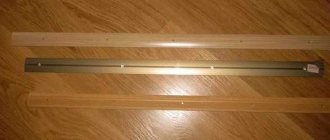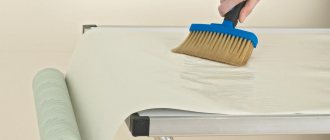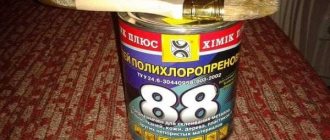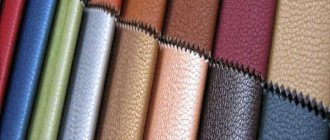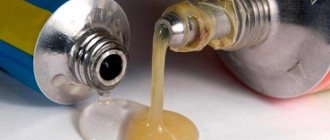Linoleum is presented on the modern market in a wide range. It is available in rolls of different sizes. Also, many stores cut linoleum to the required sizes. However, during renovation and renovation, it may be necessary to glue two strips of such flooring together. This is usually required in large areas or complex configurations.
There are several ways to glue linoleum. Previously, only the hot welding method was used for these purposes. In Soviet times, it was not distinguished by its aesthetics - the joints were ugly and conspicuous. Modern hot welding technologies make it possible to achieve a high-quality connection while maintaining a presentable appearance of the floor covering.
The joining process is carried out at a temperature of 360-400 degrees. But only fairly dense and hard material can be welded using this method. For most household varieties of linoleum, high-temperature soldering is not suitable.
For soft linoleum coverings, so-called cold welding
. This is a method of joining material using polyvinyl chloride-based adhesive, also suitable for hard types of rolled floor coverings.
When linoleum comes into contact with PVC glue, a chemical process occurs, due to which the strips of material are securely glued to each other. In this case, no deformation of the linoleum occurs near the joint area. Hot welding warps soft synthetic materials to one degree or another.
Methods for joining linoleum
- Double sided tape. Even beginners can use the method. To secure the strips of linoleum, you need to glue a strip of tape to their edges from the inside out. The disadvantage of this method is its impracticality and unaesthetic appearance.
- Laying the threshold on the seam. Suitable for connecting strips of covering at the entrance to a room. Thresholds are produced in various shapes and sizes. This is a reliable decorative design that is suitable for any type of floor covering. The disadvantage is the limited color range of the thresholds. In addition, the threshold forms a hill at the junction of the linoleum strips, which causes difficulties when moving around the house.
- Hot welding. The method is used for gluing commercial linoleum in rooms with intense mechanical impact on the floor surface (in government agencies, offices, hospitals, wherever many people pass daily). Linoleum for home use is less durable and can be deformed under the influence of hot welding, since the coating is soldered with a torch or electric soldering iron, heating the material up to 400 °C. To more reliably solder the strips, an filler cord is laid end-to-end between them, having an identical structure to linoleum. After cooling the coating, the deposited “scar” formed on the seam must be sanded. To weld linoleum using the hot method, you must have skills, otherwise you can ruin the coating.
- Cold welding. You can glue any type of linoleum. The joints of the strips are connected with a special compound. The installation method combines the simplicity of installation work and the quality of the final result.
Hot welding of linoleum seams
The hot welding process is based on the temperature effect on linoleum. This type of welding is usually used inside industrial premises where the floors are subject to strong mechanical stress, as well as where there is a high level of human traffic and the floors wear out very quickly. Also, using the hot method, fairly long joints are sealed.
Hot welding of linoleum
Hot welding is carried out using a special torch (heat gun), which can heat the material up to 400 degrees and melt it. A special filler cord is inserted into the gap between the cuts of material, which is also heated. In its structure it resembles linoleum itself. After cooling, two separate pieces of linoleum are very securely glued (soldered) together. Then the resulting “scar” is lightly polished.
Machine for welding linoleum Energy 1600 (ENERGY 1600)
On a note! If there is no special burner at hand for joining individual pieces of linoleum, then builders use a powerful electric soldering iron. However, in this case it will not be possible to achieve an ideal result - the seam will be crooked.
Also, to carry out work using the hot welding method, you will need scissors with a crescent-shaped blade. With their help, excess adhesive component will be removed. Ordinary scissors will not work here.
For hot welding of linoleum, a special device is used - a hot air gun.
Advantages of the hot welding method:
- the ability to obtain a durable and completely sealed seam;
- high reliability of the method.
The disadvantages of the hot welding technique are that it can only be used when laying dense, hard type linoleum. Low-quality and soft linoleum will simply melt and deteriorate. It is also necessary to have certain work skills in order to avoid mistakes and damage the coating. In general, if all the work was done correctly and carefully, then the gap between the individual linoleum sheets will not be visible to the eye.
Hot soldering linoleum technology
In the photo, removing excess from linoleum
Modern types of linoleum are distinguished not only by improved performance properties, but also by design: these are all kinds of colors, patterns, imitation of natural and artificial materials. How to choose linoleum so that it lasts long and reliably and what should you pay attention to when purchasing? Read in the special article.
Cold welding concept
This is a simple method of joining two strips of linoleum. It is carried out with an adhesive composition.
Cold welding adhesive works on the principle of a solvent, which “melts” the edges of the floor covering. Liquid linoleum on both sides at the junction reliably and firmly connects them to each other, forming a thin, almost imperceptible seam after cooling. You can weld joints of any width. The formed seams will have the same characteristics and elasticity as the main linoleum sheet.
The glue is very toxic, so all actions must be carried out in compliance with safety precautions. Personal protective equipment is used.
Adviсe
The process of cold joining a felt covering is better and easier if you take into account some useful tips:
- When buying linoleum, you need to take into account that for gluing and leveling the canvas you will need an overlap of the sheets of approximately 6 cm. This is required to create the most even edge possible, ensuring a high-quality joint;
- Distribution of glue from the tube should be done through a needle tip. This device fills the gap between the edges as much as possible and avoids erroneous application of the composition;
- If adhesive liquid accidentally gets on the coating, do not immediately try to wipe it off. You need to wait until the glue has completely dried, then remove the hardened composition with a stationery knife.
Remove any remaining adhesive from the seams.
Joining the coating by cold welding is an affordable and effective method of fastening linoleum that does not require a special set of tools or cord. In this way, you can glue both new and used flooring. Following the instructions and taking into account the nuances of the work leads to the creation of a high-quality connection.
Did the article help you? ( 10 ratings, average: 4.60 out of 5)
Advantages and disadvantages
Welding is chosen when they are renovating a home and want to ensure that the linoleum seams on the floor are not visible to the naked eye.
Advantages
- Gluing the canvases is done quickly and with a high-quality result.
- No auxiliary tools needed. Everything you need is included with the adhesive. You may only need double-sided tape to cover the joints.
- The cost of the work will be low both for gluing new flooring material and for working with the old coating.
- The junction of the canvases will be almost invisible, visually it will look like ordinary linoleum.
Flaws
- High toxicity. The product contains components harmful to humans. Work with the mixture is carried out in a respirator. It is necessary to check the composition's compliance with all standards.
- Limited use. Only single-layer material can be soldered by welding. When gluing multilayer linoleum, the seam will be rough and very prominent. Welding is not recommended if insulation is placed under the main covering or the material has a felt base.
Cold welding or the most popular method No. 5
Without the experience to qualitatively and, at the same time, imperceptibly weld a linoleum seam at home with your own hands, the easiest way to join it is by cold welding.
To explain it in a nutshell, this is pure surface gluing. Only instead of regular glue, special compounds are used. They are selected depending on the type of linoleum and the specific connection conditions.
Tube “Cold welding”.
Types of adhesive composition
Since you won’t be able to properly glue linoleum with anything, you will need to choose one of three options.
After all, if the package says “Cold welding”, this does not mean at all that this composition is right for you.
- “Cold welding” type “A” is most often used. This composition has a fairly liquid consistency, thanks to which it easily penetrates into the pores of soft linoleum. Typically, such linoleum is used for residential premises; some also call it foam, although this is not true. If you are going to glue a new canvas, then this is exactly your option;
- The composition marked “C” will already be much thicker. This consistency allows gluing surfaces with a gap of up to 3 - 4 mm. Theoretically, it can also be used for gluing new coatings, but type “C” was developed more for repairing torn sheets and gluing open cracks. This connection method is somewhat reminiscent of hot welding with a hot air gun, only instead of a soldering iron and a polymer cord, a wide linoleum seam is filled with a jelly-like substance;
Different types of compositions.
- Cold welding type “T” is not suitable for amateurs at all. It is used in a narrow niche of polyester-based PVC coatings. Working with such a composition requires serious practical skills; in addition, it is quite toxic and it is dangerous to work with it without training.
Cold welding technique
The question of how to properly glue linoleum using cold welding, due to its particular popularity, deserves more detailed consideration. As I already mentioned, the type “A” is most often used here. Any packaging of this type is equipped with a kind of adapter with a thin needle, through which it is convenient to introduce the composition between tightly connected sheets.
Wide tape.
You don't need too many tools. What you need, you will need to buy a roll of masking or regular stationery wide tape and a sharp knife, just don’t take a stationery knife, it is too weak to cut linoleum. To ensure an even cut, you can take a metal ruler or any even metal strip. I use a long building level; in addition to being level, this tool also does not bend.
When you lay the flooring in your home, first cover the room with linoleum in the position in which it should lie and leave it there for a week. During this time, it will adapt and all you have to do is glue the seams, evenly trim the excess fabric around the perimeter and press it along the contour with plinths. Believe me, it won’t go anywhere and will stay there for as long as you like.
Trimming linoleum sheets.
This method of installation allows you to do without gluing the canvas over the entire plane, which is not only cheaper and simpler, but here you can also easily remove the canvas and use it for other purposes. For example, if you decide to change the covering, then it will not be difficult to roll up the old linoleum and take it to the dacha.
Gluing order.
The base, that is, the floor, no matter what it is made of, must be clean and perfectly flat. From my own experience, I’ll tell you, don’t expect that thick linoleum will hide cracks and uneven floors. When the canvas settles, all existing defects will appear on it.
In order to ensure a tight, imperceptible seam without the slightest gaps, the two canvases are overlapped. If matching the pattern is not required, then an overlap of 3–4 cm is sufficient, in other words, the width of the tape. When dealing with a pattern, decide for yourself, but after cutting, the pattern on adjacent surfaces should completely match.
Cold welding glue is an aggressive thing; a carelessly falling drop can easily ruin the surface of the linoleum. In order to protect ourselves from such incidents, we will use tape.
Laying linoleum.
First, the top sheet is folded back and in the middle of the future connecting seam a piece of tape is glued along the bottom sheet. After this, in the same place the same tape is glued to the top sheet.
Now place a metal ruler in the middle of the tape and press it tightly, after which you cut this entire cake all the way to the floor with a knife. By removing the trim from the bottom and top, you will get a tight, even connection, both sides of which will be protected with tape.
Next, you will need to take a tube of cold welding, immerse the thin needle of the adapter deep into the seam and fill it so that the composition protrudes slightly from above (the needle is immersed approximately to the middle of the thickness of the fabric). You need to squeeze out simultaneously with the movement of the tube along the seam.
Combining the drawing.
Any glue that comes out from above does not need to be wiped off immediately. The edges of our canvases are protected with tape, so you should wait until the composition is completely dry, and then, by pulling off the tape, you will get a clean seam. If there is any small excess left, you just need to carefully cut it off. If everything is done correctly, the seam can only be found by touch.
Linoleum repair
In the case when you do not plan to change the coating, but there are unpleasant cracks on it, you can repair them using cold welding grade “C”. The main thing here is to carefully fill only the crack itself with the compound, because accidentally smeared glue can make it even worse than it was.
Seam filling.
Before gluing torn linoleum or cracks in the canvas, the defect site will need to be thoroughly cleaned and degreased. After this, tape is applied directly to the tear site. Now take a blade and cut out this very crack along the edge in the tape. It’s like a “surgical operation” when everything around is sealed and access is only to the site of the tear.
Next, you will need to carefully fill the crack with glue and wait until it dries. At the end, the tape is removed, and the protruding patches of glue are carefully trimmed with a knife. Theoretically, you can use any tape, but in this case I prefer to work with transparent stationery tape. The crack is clearly visible through it, making it much easier to cut out.
Needle for filling the seam.
If we are talking about a fresh rupture of the canvas, for example, due to careless movement of furniture, then while the edges of the canvas have not yet become severely deformed, it makes sense to glue with cold welding type “A”. Much the same way you would glue new surfaces together.
In this case, I stick tape, make a cut along the contour of the tear, fill the seam with glue, and cover everything on top with a rag or paper napkins and place a weight. Excess glue is absorbed into the rag, the next day, the tape, along with whatever is stuck to it, simply comes off, you only need to lightly clean the seam with a blade and that’s it.
Welding type "C".
Compound
Many manufacturers produce glue for linoleum joints. Most of them will have a similar list of components.
- Solvent. More often it is tetrahydrofuran containing chlorine, which affects PVC, melting it. The component has practically no effect on other types of linoleum. This must be taken into account when choosing an adhesive, because manufacturers can add other polyurethanes to the flooring instead of polyvinyl chloride.
- Filler. Often this is PVC in liquid form.
The characteristics and types of mixtures may differ due to different ratios of elements in the composition. For example, type A has more solvent than type C, and type C has a much higher percentage of PVC.
Features of cold welding floor repair
If there are no plans to replace the old linoleum, but there are already tears and cracks on it, you should choose cold welding as a method of repairing the floor covering. This work is easy to do with your own hands.
It is better to choose type C glue for linoleum. This is explained by its thick consistency. This composition is more suitable for connecting linoleum joints than type A glue. It can be used to seal even wide joints. The procedure for sealing cracks in old linoleum is the same as for joining new pieces.
Kinds
There are 3 types of welding mixtures, differing in consistency. To choose the composition, consider the width of the gap between the parts of the material being glued.
| Type | Characteristic |
| A | Contains a large proportion of solvent. The use is justified when there is a very narrow gap between the strips of the material being glued, no more than 1 mm wide. The composition is very liquid and easily penetrates into the gap, the main thing is that the joining is made without overlapping of the panels. The easiest way to work is when joining factory edges. The result is an almost invisible seam. This is the most suitable type of welding for home use. |
| WITH | A thicker mixture that can be used to seal gaps more than 2 mm, but not more than 4 mm thick. The composition contains less solvent, but more PVC. Having filled the seam, the mass hardens, forming a strong connection. The product efficiently connects even uneven edges of the material. Type C can be used during the restoration of old floor coverings. |
| T | For home linoleum, type T is rarely used. It is used by professionals when working with multi-component coatings. Manufactured from PVC and polyester. The created seam is elastic and durable. |
Useful video about cold welding linoleum
Viewed times: 3,882
Great article 0
Author's rating
Author of the article
Oleg Grishin
Flooring specialist with 10 years of experience. Oleg has something to share with our readers
Articles written
105
- Even more interesting:
- Features of caring for linoleum
- Which linoleum adhesive should I choose for a concrete floor?
- Types and characteristics of commercial linoleum
Consumption: influencing factors and figures
- Professionalism of a person. An experienced repairman will use glue sparingly to avoid large amounts of waste. Beginners, while they get the hang of it, can use more solution than required by the instructions for use.
- Thickness of the floor covering. The thicker the linoleum, the more mixture will be used for gluing. Too thick PVC is rarely used in everyday life. In a conventional coating, the PVC layer is located on top, and the substrate does not react with the adhesive solution.
- Type of glue. The consumption of type A mixture is 50-60 ml per 25 line of seam. And for the same length of seam, type C glue needs one and a half times more.
To accurately calculate the amount of welding mixture, you need to accurately calculate the length of the seams.
Procedure
The “Cold Welding” adhesive composition begins to react with PVC products, so you should prevent the glue from getting on the linoleum itself outside the joint. To eliminate this situation, apply masking tape to the surface of the pieces being joined. Then, using a construction knife, a furrow is made along the joint. You need to pour adhesive into the cut. After a little time, the masking tape is removed. You can make sure that the joint has become invisible.
Advice! When the glue dries, the remaining sagging of the composition is cut off with a knife. If cold welding of linoleum is done well, the seams will not be visible.
For floor coverings that are 3 mm thick, it is enough to use a 60 ml tube of glue. It is enough for 30 linear meters. This value changes depending on how well the work is done.
To ensure that the pieces of linoleum fit together as closely as possible, you should follow the recommendations of experienced builders when performing cold welding. It is important to take care of several subtleties of the process. It is important to follow the technology exactly. It consists of the following stages:
- In the place where the seam will be made, it is necessary to stick double-sided tape. This is necessary so that the glue does not start to spread over the finish coating.
- Then the strip of tape is cut with a knife at the junction of the linoleum. It is better not to touch the coating itself.
- Then you should put a nozzle with a needle on the tube with the adhesive composition. The composition will be squeezed out through it.
- The needle should be carefully inserted into the cut, and then the glue should be easily squeezed into the gap. When it appears on the tape you should start moving forward.
- After filling the entire length of the gap, you need to leave the joint to dry. This one will take 15 minutes.
- All that remains is to remove the tape.
Such features of the linoleum cold welding technology should be kept in mind when performing work.
Manufacturers and brands
- WernerMuller. This is a German manufacturer that produces cold welding of all types, the quality of which meets all international standards. Werner Müller type A glue is most often used; it forms a strong seam at the junction of the material. Consumption – 44 g per 25 m.p.
- Tarkett. Universal composition made in Germany. When gluing, it forms a completely invisible, durable, airtight seam. It comes in the form of a tube with a needle that does not bend or break and makes it easy to apply the composition. You can glue any type of linoleum, including multi-layered and with uneven edges.
- Homakol S 401. A domestically produced product used to glue PVC boards and linoleum for commercial use.
- Rico. The composition is safe for humans and does not contain toxic tetrahydrofuran. It is replaced by artificial rubber or polyurethane foam. The price of the product, consumption and quality of gluing corresponds to the previous ones class=”aligncenter” width=”720″ height=”405″[/img]
- "Second" and Sintex. These are Russian and Spanish brands, respectively. Both funds belong to the budget category. Consumption does not exceed 45 g per 50 line seam.
- Tytan. The brand hides a whole series of cold welding products for linoleum. The most popular glue is Tytan 100 ml “White”, which is a one-pack product. It is in the form of a rod with a volume of 0.1 liters, inside of which there is a solvent and a base. Shake the bottle thoroughly before use. Consumption – 1 cylinder per 45 line of seam. You can glue PVC and metal. The glue can withstand heavy loads. The adhesion time to the surface is no more than 5 minutes. And they also sell Titanium type C, which can be used to seal gaps up to 0.4-0.5 cm in width. It comes in two-pack form. Before gluing, the adhesive components must be mixed. A durable, heat-resistant seam is created that can withstand temperatures up to +150 °C.
- Axton. A Polish product, available in the form of 60 g tubes. During gluing, the seam does not become covered with bubbles, and the linoleum does not ripple. The glue dries quickly and seals gaps no more than 3 mm wide. The downside is the difficulty of applying the mixture to tight joints due to the thick spout of the package and the lack of a needle. One bottle is enough for only 5 lines of seam. After drying, the seam shrinks, so you need to immediately apply a large layer of the mixture.
Video reviews
Existing methods of joining materials
It would be wrong to label and categorically state that there are good and bad docking methods. Since these methods exist, it means that they are in demand in some niche. Since linoleum joints can be glued together in different ways, the main thing here is to correctly determine which method is suitable in a particular case.
Method No. 1 - landing with double-sided tape
Let us say right away that this method is fast, very easy to implement, but not very reliable and not durable. After all, adhesive tape, even the highest quality, was originally developed for temporary, lightly loaded connections.
Double sided tape.
Double-sided tape is a good thing, but it has one flaw: such tape will not adhere tightly to a porous surface. Therefore, before installation, any base, be it a cement screed, wood or a concrete slab, must be treated with strengthening soil.
A felt-based covering cannot be properly joined using double-sided tape.
Felt-based linoleum.
When the soil has dried, you need to remove the protective tape from below and glue the tape itself to the base. After this, with one hand you pull off the top protective tape, and with the other hand you simultaneously press the edges of the joined sheets. Upon completion of this procedure, it is advisable to roll the joint well with a hard roller. That's actually all the wisdom.
In fact, this method has only two main and only advantages. It's low price and simple. Otherwise, I personally can recommend it as a temporary option lasting a maximum of a year. Then you will have to glue it as expected or change the coating.
Method No. 2 - overhead sill
The range of plastic and metal sills, although not particularly large, is usually possible to choose from.
As for complexity, the instructions for installing such thresholds with your own hands are not far removed from double-sided tape.
Overlay threshold.
- Each such threshold has ready-made holes for fixing with self-tapping screws . First, you need to cut the strip to size and, placing it at the junction of the two panels, mark the entry points of the screws;
- After this, take an electric drill and use a six-millimeter drill to make a series of holes according to the markings . Plastic dowels are immediately inserted into these holes;
- Now all you have to do is attach the bar and secure it with self-tapping screws.
Thresholds with holes for screws.
Everything would seem beautiful, but the problem is that the threshold is overhead, naturally it will stand out strongly on the floor surface. Since it is not necessary to glue the linoleum here, in fact, you just press it well, this method is perfect as an interior transition in the area of the doorway. Or to connect two different coatings, for example, tiles and linoleum.
Method No. 3 - mastic
This method can safely be considered the patriarch of this direction. Mastic is a type of adhesive. In those days when the range of linoleum was, to put it mildly, small, all coatings of this type were glued to the base using mastic. The method is quite reliable, but if everything is done as expected, it will not be possible to dismantle such a canvas without tearing it.
Nowadays, quite often people prefer to use mastic only to join two canvases. Many craftsmen believe that gluing linoleum over the entire area is only relevant for industrial and public premises with high loads, and on this I agree with them. At home, there is no point in completely fixing the canvas; it won’t go anywhere anyway.
Applying mastic with a spatula.
This method is somewhat reminiscent of gluing with double-sided tape. In the same way, before gluing the joints of linoleum, the base will need to be primed, and the edges of the canvases will need to be degreased with any alcohol-containing solution. Just don’t try to degrease it with acetone or any solvents, because some models of linoleum can simply be corroded by these compounds.
After this, in the area of the joint, mastic is spread on the base with a spatula, and the edges of the canvases are pressed; for reliability, you can also roll the joint with a hard roller. Only mastic is not adhesive tape; it will dry for about a day. And until it completely hardens, the edges of the linoleum should be pressed tightly. Usually a board is placed at the joint and a weight is placed on it.
Method No. 4 hot welding
Hot welding is a thorough and very reliable method, but it is not suitable for everyone. In this way, only high-density linoleum can be connected, which is most often used for arranging floors in industrial enterprises and administrative buildings. Models intended for the residential sector are too thin and “loose”; at this temperature they simply melt.
Hot air gun for hot welding.
But anything can happen in life, and perhaps in your case this will be what you need. I warn you right away that compared to other methods, hot welding is the most expensive.
To work, you will have to get a special hot air gun. In appearance, it looks like a regular soldering iron, only it is heated using hot air. In principle, the price for it is high, but the instrument is specific and highly specialized, so it is better to rent it.
Main stages of hot welding.
Hot welding can only be performed if the coating is glued over the entire area of contact with the floor. First, the canvas “sits” on the mastic, and after it has firmly set, you can begin to weld the seams.
Working with a hot air gun.
- Hot welding is similar to classical welding methods. The solder here is a special polymer cord. It is inserted into the nozzle of a hot air gun and, as it melts, fills the seam between the two sheets;
- First you will need to widen this seam. Some craftsmen prefer to simply join two edges with a small gap of 2 - 3 mm; theoretically, this can be done, but this is not entirely true. It is better to first join the two sheets without a gap, and then cut a V-shaped groove along the seam. Professionals use a special cutter for this, but at the amateur level a good sharp knife will do; I use an oblique shoe knife;
- The cross-section of the cord should be a couple of millimeters larger than the groove between the blades. It goes without saying that there should be no debris in the groove, and the edges of the linoleum should be degreased;
Scheme of hot welding of linoleum.
- Naturally, each soldering iron has instructions, plus there should also be an annotation on the packaging of the polymer cord. But if for some reason you do not have this information, then keep in mind that the average melting temperature of the polymer ranges from 300 to 500ºC;
- When the cord is inserted and the tool has reached the desired temperature, the tip is brought close to the gap between the sheets and as it fills, the hot air gun moves along the seam. I simply place the tip on the groove and move the soldering iron;
Welding kit.
It is better to solder the canvases first from one wall to the middle, and then in the same way, from the opposite wall to the middle. The joints are joined with an overlap of about 30 mm.
- The joint must be filled completely, so that the liquid polymer protrudes above the joint. If the cord doesn't melt well, add a little heat. After finishing welding, leave the joint alone so that the polymer hardens;
- Now you will need to take an arched knife and carefully cut off the excess that is protruding. Just don’t try to “put things in order” while the polymer is still liquid, the fact is that it tends to shrink and if you rush, you will have a groove in place of the seam. The best time is when the composition has already set, but is still warm.
A cutter for expanding the seam.
There is one more nuance in hot welding technology. No matter how hard you try, you will not be able to achieve an invisible seam. The welding will be clearly visible; creative individuals often use this to create original linoleum panels.
To be completely honest, hot welding is only as easy as you read about it. When it comes to direct welding, without experience, you will have to tinker a lot. Therefore, it makes sense to think about hiring a specialist.
How to glue linoleum using cold welding
To properly seal the joint between two sections of the coating, you must strictly follow the instructions. To work you will need tools:
- long ruler (preferably metal);
- masking tape (can be replaced with regular double-sided tape);
- knife for cutting (the sharper it is, the better the quality of the seam and the better the joining of the blades will be);
- substrate for cutting linoleum (thick cardboard, old plywood, an extra piece of old linoleum or chipboard);
- protective equipment (gloves, mask or respirator to prevent inhalation of harmful fumes from the mixture).
Seam formation
- Lay two flooring sheets on top of each other with an overlap of 50 mm. Under the joint, you must first place a substrate (cardboard, chipboard, old coating) along its entire length.
- Markings are applied to the top strip indicating the location of the cut, approximately in the middle of the overlap.
- First, excess pieces of material are cut off, and then a cut is made with a sharp knife along the entire length of the previously drawn marking. You need to cut two blades at the same time, which will make the most even joint with minimal discrepancy.
Cleaning the base and seam
Before gluing the linoleum, the floor is cleaned of dirt, the old covering is removed, and dust is collected with a vacuum cleaner. Dry all parts well and protect their edges from damage.
Many brands contain aggressive components that can destroy the structure of the material; glossy coatings can especially suffer. To prevent this from happening, the edges of the surface must be covered with masking tape, leaving only a few millimeters of the edge to interact with the glue. The edges of both strips are protected.
Applying glue
The product can be applied using two methods.
- In the gap between the canvases. If the product has a thin spout or needle, then it can be squeezed onto both sheets. The edges will immediately melt and join together.
- Separately for each canvas. First, one sheet is lubricated and applied to the floor. Then the second part is glued and joined to the first. The seam is leveled and smoothed.
If double-sided tape was used to protect the edge, it can be removed after 15 minutes. after applying glue. Final coupling will occur in approximately 3 hours. Afterwards, you can walk freely on the floor without fear of disturbing the arrangement of the paintings.
When working with the mixture, you should have cotton pads or a clean sponge on hand to remove excess glue.
Video
Removing excess glue
It often happens, especially among beginners, that excess glue spills out. When gluing, you should not touch them, so as not to provoke peeling of the floor covering and deformation of the seam.
You can remove excess glue after drying. This is done in two passes, as pressing too hard may cause a dent. First you need to trim off any excess glue that oozes out, and after a day, complete the cleaning process. Even a beginner can perform all the steps if he strictly adheres to the instructions and safety rules.
Linoleum
0 votes
+
Vote for!
—
Vote against!
Aesthetic appeal and good performance characteristics, a variety of design and color solutions, safety and durability of use distinguish linoleum into a separate group of modern floor coverings, and the ideal ratio of high quality and affordable price makes its use almost universal.
Content:
- Methods for joining linoleum
- Hot welding
- Cold welding
2. Cold welding of linoleum with glue: varieties
3. Technological features of cold welding
- Creating a Weld
- Cleaning the future seam
- Cold welding application
- Removing excess glue
Methods for joining linoleum
Being a universal floor covering, linoleum is successfully used in residential and office premises, warehouses and industrial areas. To perform high-quality linoleum flooring, the contractor must have extensive experience and knowledge of the basics of installation technology, a professional approach and accuracy. When arranging a floor with linoleum, non-standard situations may arise that require prompt and, most importantly, correct decisions to be made. So, for example, during the work process, quite noticeable gaps can form at the joints of the canvases, which can only be hidden and made into a single piece by using hot or cold welding for linoleum. To get a high-quality seam, you must follow certain rules and recommendations.
The main methods of welding linoleum with your own hands are 2 methods:
- hot way
- cold way
each of which has its own undeniable advantages. At the same time, we note right away that the simplest and least labor-intensive method, which does not require special skills, is cold welding of linoleum with glue, while hot welding is a very painstaking job, which can only be completed by an experienced professional using special tools.
Hot welding
Hot welding is applicable for sealing seams of commercial linoleum in those rooms where there is a significant intensity of mechanical impacts on the floor surface, for example, in public buildings. This coating is characterized by increased strength and high cost, which means it will require professional skills and a special tool - a welding heater (soldering iron) and filler rods with a round or triangular profile made of plasticized polyvinyl chloride. Note that high-quality welding is possible only after gluing the coating to the floor surface, so the best time to perform welding activities is the next day after gluing.
The technology for welding linoleum is as follows:
Before starting work, edges are pre-cut on adjacent panels specifically to the shape of the rod, thereby forming V-shaped grooves. A welding heater is used to generate hot air streams. Moving through the heating elements, the temperature of the compressed air rises and reaches 300-400 °C in the area of the tip. During the welding process, the torch, and along with it the filler rod, is passed along the joint. The flow of hot air softens the surface of the linoleum and the two sheets are reliably welded under the action of the pressure roller. After the seam has cooled a little, using an arc-shaped knife or a flat chisel, carefully cut off the part of the fused cord protruding above the coating and grind the seam until a smooth surface is obtained.
If you don’t have a welding torch at hand, then you can use a regular soldering iron, which can probably be found on a workbench. However, the result may be disappointing - you will not be able to get a uniform, beautiful seam along the entire length of the coating. Therefore, if you need a high-quality, perfectly even seam and you do not have special equipment, then it is better to use cold welding.
Cold welding
So, what does the expression “cold welding for linoleum” mean - a combination of seemingly two opposite concepts? The answer lies in the technology of connecting two canvases - a special glue, being a solvent, turns the edges of the material into a liquid state in a short period of time. The canvases are connected, and after the solvent evaporates, an aesthetic connection of increased strength is formed. The technological process of cold welding completely eliminates the treatment of linoleum with hot air.
The end result - a strong and smooth connection - is in no way inferior in quality to the result of a joint based on temperature fusion, and there is no need to purchase an expensive soldering iron. Therefore, to connect household covering sheets, as well as to obtain an intricate or complex (in shape and configuration) seam, experts recommend using the method of cold welding of linoleum, the price of which is affordable for any category of buyers. The main disadvantage of the method is that the adhesive contains volatile solvents that are harmful to human health. Therefore, when performing cold welding, ensure fresh air movement in the room.
Cold welding of linoleum with glue: varieties
Depending on the glue used, cold welding can be of two types:
- cold welding with A-glue,
- cold welding with C-glue.
Have you purchased linoleum and, having barely had time to lay it out, want to combine several of its parts into a single piece? Then use the first type (A), designed specifically for welding seams of “freshly laid” coating. But if your floor covering has had time to sit in the apartment for some time, and you begin to notice slightly loose seams, then it is better to use the second method (C). The main difference between glue A and glue C is consistency, in other words thickness.
C-glue is much thicker, since its task is to connect the separated joints of two canvases, and this is several millimeters. By pouring glue C between the covering sheets, you fill the empty space, which, after drying, forms an extremely strong bond. Cold welding can be done without tape, since the thick glue will not spread, which means that the likelihood of unwanted melting of the coating is zero.
How to glue linoleum using cold welding with A-glue?
A-glue “works” in a completely different way: new parts of linoleum tightly laid on top of each other must be bonded. The glue actually melts the edges of the coating, forming a solid and perfectly smooth panel. The unique properties of the adhesive ensure a high-quality and durable weld on the floor covering, especially if it is securely glued to the subfloor.
Technological features of cold welding
Creating a Weld
If the flooring has been purchased but not yet laid, then the primary task will be to trim the sheets to obtain a minimal seam. To do this, overlap two parts of linoleum (at least 5 cm). The cut line will be located in the middle of the overlap. Using a pencil and a ruler, markings are applied, along which the material is subsequently cut with a special wallpaper knife. The edges obtained in this way will fit perfectly together.
The reliability and durability of the weld, and linoleum in general, are determined by the strength of the fastening and the immobility of its edges. It should be remembered that glued linoleum does not deform during operation, it is not afraid of wet cleaning in the room and even rearranging pieces of furniture. The covering can be glued to the floor using glue or double-sided tape.
If your room has an area of more than 20 sq.m., then gluing the covering is a mandatory stage in the design of the floor space.
Cleaning the future seam
Since the glue contains harmful volatile solvents, gloves become a mandatory attribute of the welding process. Using a vacuum cleaner, thoroughly clean the joint from particles of dust and dirt. If water gets into the seam, wipe it dry.
Since cold welding, coming into direct contact with the front surface of the floor covering, can make it less attractive and spoil the overall impression of the interior, you should think about protecting the edges of the linoleum panels, especially if the linoleum has a glossy surface. To avoid unpleasant surprises in the form of damaged, melted coating, you need to use wide, single-sided masking tape. It can be glued in two strips to each panel along the edge, or one strip can be glued to the future weld. Then carefully cut the tape at the connection area, avoiding possible damage to the coating.
The photo shows soft linoleum, for welding which two strips of masking tape are used.
Cold welding application
To perform cold welding, you must carefully cut the tape over the joint of the panels, and when applying the adhesive composition, you should take into account the presence of a “needle” on the tip of the tube, along which the glue will flow. Therefore, to avoid excess glue getting onto the surface of the coating, keep a cotton swab ready. Slowly apply glue to the joint between the panels being fastened. To do this, just run the tube along the seam, evenly dosing the composition along the entire length of the surface to be treated. While working, maintain the height of the glue strip at 4 mm and monitor the movement of the needle strictly along the cut.
There are two ways to apply glue:
The first method is to apply glue to two canvases at once, as in our example. The glue that gets into the seam interacts with the coating and polymerizes.
The second method is to apply glue to only one panel, which is processed separately and then attached to the floor surface. Next, the adhesive composition is applied to the second canvas. They are laid as tightly as possible next to the first one and carefully leveled, thereby ensuring high-quality joining of the glued pieces.
The method you choose is determined by your convenience, the consistency of the adhesive, the current condition of the flooring and other factors.
After the glue has dried (1-2 hours), you can safely walk on the floor.
Removing excess glue
After the glue has dried, you can remove the masking tape.
When performing cold welding, some of the adhesive may come out. There is no need to rush to remove excess during the welding process, since the adhesive may peel off from the coating, and this can lead to a decrease in the quality of the weld. In addition, there is a possibility that, using dirty tools, the wet layer of glue will become dirty. And finally, the last argument is that dried glue is easier to cut off.
Note! Fresh cold welding is a little springy, and at the moment of tension when cutting, a depression may appear, so it is recommended to remove excess in two passes.
As you can see, cold welding of linoleum is a simple job that absolutely anyone can successfully handle!
You can learn how to cold weld linoleum at a high quality level and in a short time from the video on YouTube.
Existing varieties
Felt-based linoleum is only heterogeneous.
There are mainly two types of felt linoleum on the modern market.
The first option provides for the presence of five layers, each of which fulfills its “responsibilities”:
Rules and features of laying new linoleum on old
- The external one, which is a transparent polymer, reflects all external negative influences.
- The second one also has a protective function and has a thickness of 0.7 mm.
- The third is decorative, responsible for the aesthetics of the coating.
- The fourth is the very layer of felt that distinguishes this type of linoleum.
- The fifth is represented by a layer of dense polyvinyl chloride.
In the second case, linoleum already consists of 7 layers, namely:
- The outer layer is made of polyacrylic or PVC.
- The second, consisting of the same PVC, enhances the protective properties. The existing GOST obliges manufacturers to make this layer 0.15-0.8 mm thick.
- The third is decorative.
- The fourth is foamed PVC.
- The fifth is stabilizing fiberglass.
- Sixth – Felt backing.
- The seventh is additional waterproofing that preserves the felt.
